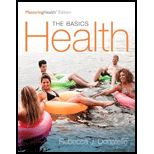
Health: The Basics, The Mastering Health Edition (12th Edition)
12th Edition
ISBN: 9780134183268
Author: Rebecca J. Donatelle
Publisher: PEARSON
expand_more
expand_more
format_list_bulleted
Question
Chapter 13, Problem 4PQA
Summary Introduction
To discuss: information regarding digestive related disorders
Introduction:
The musculoskeletal disorders are the clinical situations where there effect on muscles, joints and bones. These diseases are very common when the age increases. The diseases constitute tendinitis, osteoarthritis, fibromyalgia, and carpel tunnel syndrome and rheumatoid arthritis.
Expert Solution & Answer
Want to see the full answer?
Check out a sample textbook solution
Chapter 13 Solutions
Health: The Basics, The Mastering Health Edition (12th Edition)
Ch. 13 - Prob. 1WDYTCh. 13 - What actions can you take to reduce your risks?Ch. 13 - Prob. 3WDYTCh. 13 - Prob. 4WDYTCh. 13 - Prob. 5WDYTCh. 13 - Prob. 6WDYTCh. 13 - Prob. 7WDYTCh. 13 - Prob. 8WDYTCh. 13 - Prob. 9WDYTCh. 13 - Prob. 10WDYT
Ch. 13 - Prob. 11WDYTCh. 13 - Prob. 12WDYTCh. 13 - What actions can you take to reduce your risks?Ch. 13 - Prob. 1PQCh. 13 - Prob. 2PQCh. 13 - Prob. 3PQCh. 13 - Prob. 4PQCh. 13 - Prob. 5PQCh. 13 - Prob. 6PQCh. 13 - Prob. 7PQCh. 13 - Prob. 8PQCh. 13 - Prob. 9PQCh. 13 - Prob. 10PQCh. 13 - LO 1 | The Process of Infection 1 What are three...Ch. 13 - Prob. 2TAICh. 13 - Prob. 3TAICh. 13 - Prob. 4TAICh. 13 - Prob. 5TAICh. 13 - Prob. 6TAICh. 13 - LO 5 | Common Types of Sexually Transmitted...Ch. 13 - Prob. 8TAICh. 13 - You can always tell when youve got an STI because...Ch. 13 - Some STis can be passed on by skin-to-skin contact...Ch. 13 - Prob. 3AYCh. 13 - Oral sex is safe sex.Ch. 13 - Prob. 5AYCh. 13 - As long as you dont have anal intercourse, you...Ch. 13 - All sexually active females should have a regular...Ch. 13 - Once genital warts have been removed, there is no...Ch. 13 - You can get several STIs at one time.Ch. 13 - Prob. 10AYCh. 13 - Prob. 11AYCh. 13 - All STIs can be cured.Ch. 13 - You can get an STI more than once.Ch. 13 - Prob. 1PQACh. 13 - Prob. 2PQACh. 13 - Prob. 3PQACh. 13 - Prob. 4PQACh. 13 - Prob. 5PQA
Knowledge Booster
Similar questions
Recommended textbooks for you
 NutritionHealth & NutritionISBN:9781337906371Author:Sizer, Frances Sienkiewicz., WHITNEY, ElliePublisher:Cengage Learning,
NutritionHealth & NutritionISBN:9781337906371Author:Sizer, Frances Sienkiewicz., WHITNEY, ElliePublisher:Cengage Learning, Medical Terminology for Health Professions, Spira...Health & NutritionISBN:9781305634350Author:Ann Ehrlich, Carol L. Schroeder, Laura Ehrlich, Katrina A. SchroederPublisher:Cengage Learning
Medical Terminology for Health Professions, Spira...Health & NutritionISBN:9781305634350Author:Ann Ehrlich, Carol L. Schroeder, Laura Ehrlich, Katrina A. SchroederPublisher:Cengage Learning Nutrition: Concepts and Controversies - Standalo...Health & NutritionISBN:9781305627994Author:Frances Sizer, Ellie WhitneyPublisher:Brooks Cole
Nutrition: Concepts and Controversies - Standalo...Health & NutritionISBN:9781305627994Author:Frances Sizer, Ellie WhitneyPublisher:Brooks Cole Cardiopulmonary Anatomy & PhysiologyBiologyISBN:9781337794909Author:Des Jardins, Terry.Publisher:Cengage Learning,
Cardiopulmonary Anatomy & PhysiologyBiologyISBN:9781337794909Author:Des Jardins, Terry.Publisher:Cengage Learning,


Nutrition
Health & Nutrition
ISBN:9781337906371
Author:Sizer, Frances Sienkiewicz., WHITNEY, Ellie
Publisher:Cengage Learning,

Medical Terminology for Health Professions, Spira...
Health & Nutrition
ISBN:9781305634350
Author:Ann Ehrlich, Carol L. Schroeder, Laura Ehrlich, Katrina A. Schroeder
Publisher:Cengage Learning

Nutrition: Concepts and Controversies - Standalo...
Health & Nutrition
ISBN:9781305627994
Author:Frances Sizer, Ellie Whitney
Publisher:Brooks Cole


Cardiopulmonary Anatomy & Physiology
Biology
ISBN:9781337794909
Author:Des Jardins, Terry.
Publisher:Cengage Learning,